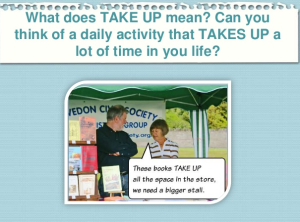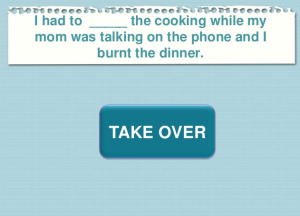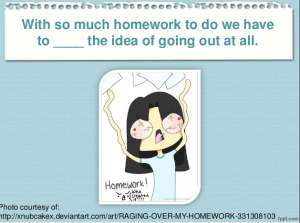Monthly Archives: April 2014
Wacky stories – Comminucative ESL Game to practise vocabulary and tenses.
| Wacky Stories | |
| Aim: | To practice vocabulary, all 12 tenses and conditional sentences (adjustable). To practice storytelling techniques (building suspense, flash-backs, flash-forwards, etc.) |
| Interaction: | Groups of three or four |
| Exercise type: | Speaking, storytelling |
| Time: | 15 minutes |
| Language: | Depends on the level of Students |
| Level: | A2 – C2 |
| Materials: | 1 set, cut up per group (the set can include as many cards as you decide and may vary depending on the level of the students). |
| Procedure: | In this activity the students make a chain story, using the words and images on the cards, as well as the tenses or grammar structures indicated on them. With a little imagination and sense of humor from your students this game can get hilarious. If you want to emphasize the use of tenses and grammar structures, there is an extra tense component on each card, this component instructs the students not only to use a noun, a verb or an adjective on the card but to construct the sentence in a certain tense. This can bring into the story flash-backs and flash-forwards (so you may need to pre-teach these storytelling techniques first).
|
The printable handout can be downloaded here >> Wacky Stories – Comminucative ESL Game
The game is also available for download on slideshare:
Phrasal verbs with TAKE and GIVE + exercise
The slideshow covers 6 phrasal verbs with TAKE and GIVE and includes exercises to practice them.
The presentation covers the following phrasal verbs:
take over
take up
take back
give back
give in
give up
The phrasal verbs are introduced with the help of comics and the built-in exercises will get the students thinking and applying these phrasal verbs in real context.
Too, (not) enough, many, very, too much/many + exercises
In this slideshow I used comic strips to explain the use of too/(not) enough/very/ too many and too much.
The slideshow also includes an exercise to practice their use.
[YouTube=https://www.youtube.com/watch?v=BRVX5gtZIpE]
Making complaints and responding to them
The slideshow covers useful phrases that can be used when making a complaint, when granting a complaint or when refusing to grant a complaint.
Learning vocabulary with songs – Activity + Teacher’s notes
This activity helps to learn at least 20 words and expressions to talk about appearance. The activity is based on the song “Freckles” by Natasha Bedingfield. The slideshow includes teacher’s notes, introduction of the vocabulary and a ready-to-use handout.
Vocabulary: appearance
Level: B1 – B2
Teacher’s Notes
1. Pre-teach the vocabulary on appearance (included in the slideshow).
2. Print out the slides with the lyrics and cut them up along the dotted lines.
3. Give each student a cut-up copy of the lyrics.
4. Play the song once (if you play it on YouTube, make sure the video doesn’t have lyrics displayed).
5. As the students listen to the song for the first time, they arrange the lyrics in order and fill in the gaps with missing words/phrases.
6. Play the song for the second time to allow the students to check their answers and to complete the gaps they have missed during the first listening.
7. As a follow-up activity, you can have a quiz on the words and phrases that the students had to use in order to fill in the gaps.

Second Conditionals Communicative Game
GUESS WHO YOU ARE/ GUESS WHAT YOU HAVE – SECOND CONDITIONALS
Aim:
To practise the use of second conditionals and vocabulary for technology, devices, gadgets, professions and everyday objects.
Interaction:
Pairs or small groups
Exercise type:
Speaking, guessing words
Language:
B1
Grammar:
Second conditional
Vocabulary:
Technology, devices, gargets, appliances, professions, every day objects
Time:
15 minutes
Materials:
A set of cards with pictures and words on them.
Procedure
1. The class is divided into pairs.
2. Each of the students gets a set of six cards with words or images on them.
3. The students need to keep the cards to themselves only, and should not show them to anyone.
4. In each of the pairs one of the students picks one of his/her cards without showing it to the others and without telling the others what the word is. Another student has to guess the word from the clues given by her/his partner.
5. All the clues must be given in the form of the second conditional, the students need to pretend that the person who is trying to guess the word already has this object/thing or is that person.

For example,
Card:
Firefighter
Clues:
If I were you, I would wear a uniform, a mask and I would carry the heavy air-tank on my back.
If I were you, I would drive the fire truck.
If I were you, I would save people and their houses.
Student, who needs to guess the word:
I am a firefighter.
Card:
Wrinkles
Clues:
If I had many of them, I would look old.
If I were an old person, I would have a lot of them.
If I had them, I would buy a lotion to get rid of them.
Card:
Glass
Clues:
If I were you, I would use it to drink juice.
If I were you, I wouldn’t drop it.
If you worked in a bar, you would have to carry many of them every day.
6. The students take turn giving clues and guessing words.
7. The game continuous until all words are guessed. Alternatively, the teacher can set a time limit and the student who has guessed the most words wins.
8. The game can also be played in groups of three or four.
A printable handout with teacher’s notes can be dowloaded here (>>Guessing game to practise second conditionals<<) and is available on Slideshare
Essay or speech about an outstanding or a famous person.
Writing an effective essay or speech about an outstanding or a famous person.
A guide for speaking and writing + exercises on speaking and writing.
In this slideshow you will find tips on writing an effective essay or speech about a famous person. It covers the rhetorical structure of the speech, the ways to make your essay/speech engaging for the audience, and some cohesive devices to make your essay/speech flow smoothly. The slideshow also includes useful phrases and vocabulary to talk about outstanding people.
Speaking activities + Teacher’s notes: Fashion and Appearance.
Speaking activities + Teacher’s notes. Talking about Fashion and Appearance. Discussion ideas and thought-provoking questions.
The PPT suggests two interactive communicative activities (“speed dating” and four corners) to encourage and facilitate the discussion of fashion and appearance.

The PPT includes 20 thought-provoking questions and ideas to get the students talking, all of the discussion questions and and both of the speaking activities were successfully used in my classes (14-24 students).
Giving an effective for and against speech.
Giving an effective for and against speech. Engaging the audience. Factors of attention. Phrases to make your speech cohesive.
This presentation covers the rhetorical structure of a For-and-against speech and includes tips on how to engage the audience and how to close your speech effectively. It lists 9 factors of attention that any speaker has to consider before giving a speech. The presentation guides you through every step of developing your next speech, from opening your speech to closing it. The presentation also includes useful phrases and linking words to order your arguments, to provide your opinion, to express disagreement or doubt, to be evasive, to talk about pros and cons and to summarize your speech.
Connectors and Linking Words
This presentation deals with a range of connectors and includes examples of their use in context. The connectors covered include: morever, nevertheless, in addition to, in spite of, in spite of the fact that, despite, despite the fact that, as well as.














